Algie Composite Aircraft 'LP1' - 385 MPH At FL290 & 14.5 GPH?
 Monday, November 29, 2010 at 12:32PM
Monday, November 29, 2010 at 12:32PM 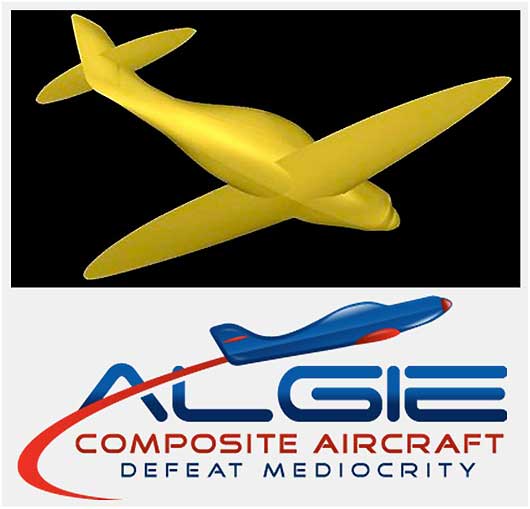
Algie Composite Aircraft LP1 rendering and logo (images: Woodward Aerospace)
(11 pix, 2 videos)
The LP1, or 'Light Pressurized 1', began over 15 years ago in the mind of David Algie. It wasn’t just an idea 15 years ago tho, work actually began on this airplane that far back, and the basic shape has been frozen for quite a long time. The LP1 is a two-place, pressurized, carbon fiber kit aircraft powered by an adapted Chevy Corvette LS engine that is intended to operate at altitudes as high as 29,000 feet (with sea level cockpit pressurization) and cruise at 385 mph burning just 14.5 gallons of fuel per hour. Even more astonishing is the goal for a 1,080 pound empty weight which will give this aircraft the ability to carry two 200 pound people, 50 pounds of baggage, and 62 gallons of fuel… all with a gross weight of just 1,902 pounds. Imagine the climb performance with 300 hp under the hood and such a light airplane!
When I first saw the airplane at Sun-n-Fun in April 2010, the claim of 385 mph on 14.5 gph along with that flashy engine compartment, and the general feeling that this airplane wasn't designed the way were used to in the aviation world is what caused me to shake my head and walk away. The 2-seat carbon airframe with an elliptical wing claiming crazy high cruise speeds, sea level pressurization at 29,000 feet, and with an automotive engine tightly shoehorned into the cowl (and an unusual looking prop/spinner nose) pretty much told me this was just another crazy dreamer. I’ve been around homebuilt airplanes since the early 70’s, since before I was even a teenager, and I’ve seen a boatload of dreamers come along and make Bede-esque claims of wild performance coupled with low cost and build simplicity... but in the end, they all disappeared.
David Algie and the LP1 featured on a STIHL sponsored video recently
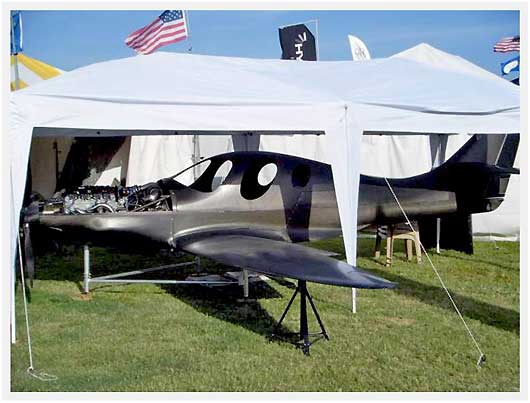 The LP1 on display at Sun-n-Fun 2010 (photo: Woodward Aerospace)
The LP1 on display at Sun-n-Fun 2010 (photo: Woodward Aerospace)
But a couple months ago I had reason to be curious enough to find out more about that ’crazy’ airplane, and the research that day opened my eyes to what just might become one of the most revolutionary aircraft of the last 40 years. The closer you look at what David Algie has not only conceived, but is getting close to having completed and ready to fly (expected sometime in 2011), the more it looks like this crazy guy really does know what he’s doing. That’s pretty impressive for a guy who’s not even a licensed pilot!
Don’t let the fact that David isn’t a licensed pilot deceive you, he’s got massive credentials to be doing what he’s doing. He’s had years of hands-on detailed experience working in the big-money world of high-end automotive racing. David has over 20 years of Indy Car design and fabrication experience. In fact, it’s the race work that kept the LP1 from being able to progress more quickly. But now he’s working full time on the LP1 and has teamed up with Texas based Woodward Aerospace to get this unique airplane to the homebuilt aircraft market. In the end, his experience with extreme (critical) carbon fiber fabrication, his exposure to high-speed full-scale race car aerodynamic wind tunnel testing, in-depth knowledge of automotive racing engines and electronics, along with intensive research in aircraft design details has all brought together a knowledge base that's likely never been combined and focused on a kit aircraft before. Possibly most important is the fact that David is very patient and has taken a long-term approach to achieving his goals with the LP1 project. 15+ years into it should be enough to convince you of that.
One of the most exciting things I learned about the LP1 in my research was that’s it’s actually being built just 2-1/2 hours away from me, in Indianapolis, Indiana. In October I was able to see the airplane up close and had the chance to speak with David for over an hour. What I saw that day was very impressive. I think the likelihood of success for the LP1 project is very high. And, in addition to the design details I’m about to share, we’re working to put together a phone interview that will soon be an AirPigz podcast… that’ll be a great way for you to learn more about this fascinating airplane and the race car guy, originally from New Zealand, that’s making it all happen.
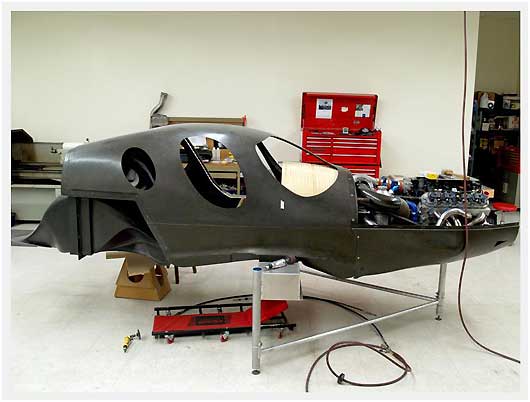 Cockpit section and LS Corvette engine installation on the LP1
Cockpit section and LS Corvette engine installation on the LP1
The list of ideas and techniques that make the LP1 different than the ‘normal’ homebuilt kit aircraft is pretty long. If it wasn’t for the depth of knowledge and experience David has, I’d be thinking right away that he’s simply bitten off too much with this combined package of ideas. But again, the closer you look, the more you see how well these ideas all work together. For example, the claimed empty weight for the airplane is 1,080 pounds. Ok, how are you gonna pull that off? Especially when the posted engine weight (including cooling system, fluids, and turbo) is 480 pounds. That leaves only 600 pounds for the entire airframe with a pressurized cockpit, control systems and landing gear.
From what I can tell, the way the carbon structure is designed has a lot to do with weight reduction. Most everything is a carbon fiber and nomex honeycomb core sandwich. David has designed and built the tooling needed to be able to build components with an inner and outer skin of carbon and with the lightweight nomex core. But even more than just using this light and strong form of sandwich, the components are design to greatly reduce the overall parts count. For example, there are no ribs in the wing. The sandwich skin is strong enough to eliminate the need (and complexity) of ribs. In talking with David, he mentioned how he was somewhat surprised to see that homebuilt airplanes using composites were predominating applying metal aircraft building techniques to this newer more exotic material. Lots of individual parts built up and then fastened together. He saw this not only as creating a tremendous amount of needless work for the builder, but also adding weight and reducing the strength potential.
This is a good example of where the Indy car experience has opened the door to some different (better) thinking. It's also a good example of why the kit LP1 will likely be much easier to build than other more common high performance composite airplanes. Due to his experience and patience, David has taken the long road to build the tooling necessary to vastly reduce the number of parts, and that investment of labor up front will pay big benefits to the end builder. Another detail that makes a difference is the way that fillets are built into the components. An integrated fillet, like the one that can be seen in the fuselage picture above where the wing will attach, will not only make a better and stronger place for the wing to cradle into, but it also adds strength to the cockpit wall. Again, with a pressurized cockpit, anything that can create added strength without adding a lot of weight is a huge plus. Another interesting point is that he’s using high temperature cure resins which means the parts are cured in a small autoclave and a large oven. This allows for all the time that’s needed for doing great layups as well as meaning you’ve got much larger operational temperature ranges for finished parts. That should mean you can paint an LP1 almost any color you want and not have to worry about it getting soft on a hot summer day!
This video gives a nice insight into the composite work done at Algie Composite Aircraft
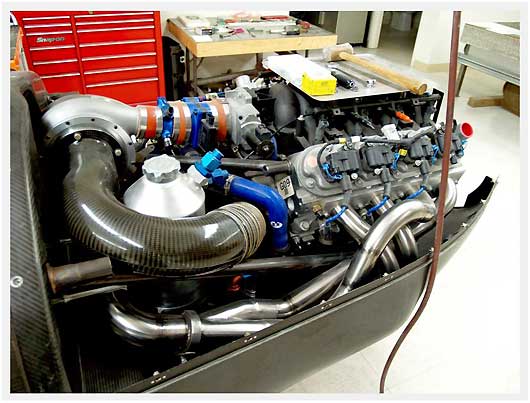 Close up of Corvette engine and turbo installation in the LP1
Close up of Corvette engine and turbo installation in the LP1
And how about that LS Corvette engine hangin’ off the firewall… that’s definitely not your standard powerplant. Even tho people have tried for years to successfully adapt a nice big automotive V-8 for experimental aircraft use you still don’t see more than a comparative handful of airplanes using one. I think a lot of the problem over the years came from people thinking they could easily make big horsepower for cheap money. But typically, the design, engineering and then the fabrication of the components needed to truly make an auto V-8 viable in an aircraft takes several wheelbarrows of money. And if you really wanna do it right, you’ll need at least one extra wheelbarrow of cash just to pay for some really smart thinkers to pull it all together. It would seem that getting the gear reduction unit right, and also taking advantage of modern electronic computer control for ignition and fuel/air management would be extremely critical elements to master if you really want to succeed.
There are some other interesting and potentially viable V-8 engine conversions available for experimental aircraft these days, but I admit that I’m not familiar with the details on them. I’m hoping to do some research before long on as many as I can find and do an extensive post comparing them. But the reality is that considering there are millions of V-8’s moving cars and trucks around, we still see very, very few of them in the air.
On the certified V-8 side, Trace Engines seems to still be getting closer to having their 600+ hp V-8 aircraft engines ready to either retrofit PT6 turboprop aircraft or be incorporated into new designs, but the effort to bring those engines to market is full of a long history of work that has its roots back in the ‘90s with the Orenda OE600 engines, which was actually an outgrowth of the old Thunder engines from the 80’s. On one hand, the prospect of realistic V-8 aircraft power is closer than it’s ever been, but it’s still uncertain if how close we really are to everyday V-8 power, whether certified or experimental.
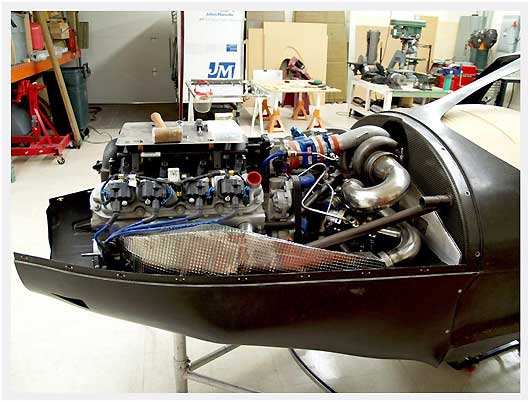 Left side view of the LS engine and turbocharger in the LP1
Left side view of the LS engine and turbocharger in the LP1
After listening to this video of David at Sun-n-Fun 2007 (it’s long, tedious and not very good audio, but fascinating), I came away believing that he has the foundational knowledge needed to effectively harness Corvette power on the front of an airplane. The other factor in his favor here is that when it’s all pulled together, this powerplant isn’t cheap… it’s not meant to be a way to pull an engine from a salvage yard and make cheap, overnight horsepower for an airplane. The stated price on the LP1 website says $62,999 will buy the engine and prop package (NOTE: initially the engine is NOT sold separate from an LP1 Kit, but will likely be eventually). That isn’t a cheap engine, however, comparing it to a new TIO-540 from Lycoming, even a non-certified version, it’s actually a pretty good buy for 300 hp. It’s also important to note that David has the engine turbo-normalized, meaning that it’s turbocharged, but it’s designed to produce and maintain essentially the same power output regardless of altitude. So, making 300 hp at 29,000 feet means this is a pretty spectacular powerplant for the money.
By the way, the fast build kit for the LP1 is currently posted at $86,999, and delivery positions can be secured with a $5,000 deposit (refundable, transferable, and escrowed)… approximately 9 slots have been purchased so far. In all, the projected cost to purchase and complete and LP1 kit is currently $160,000 to $199,000. If the airplane performs anywhere near the goals, and for the level of technology and advance work put into the project, that’s a very good value.
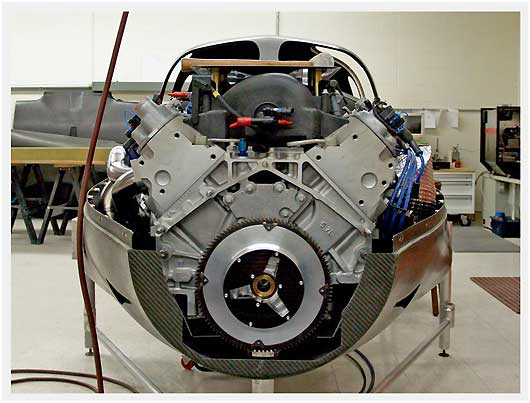 Front view of the 300 hp turbo-normalized LS Corvette engine in the LP1
Front view of the 300 hp turbo-normalized LS Corvette engine in the LP1
Once again, the Indy Car experience that David has means he understands most of what you can and can’t get away with when using a V-8 in a tight engine compartment. Safely dealing with heat from the exhaust and the turbo as it relates to the cowling etc is very important, but the race world has several materials and methods that seem to translate well to ‘inside the cowling’. There are many details to talk about here concerning the engine installation, but since I only know a few of them, we’ll plan to cover more of this in the podcast interview coming up before long.
It’s also interesting to note that David sees the LP1, or a modified version of it as a great potential race aircraft for Reno in the Sport Class. With a beefed up cabin for increased crashworthiness in the event of an off field landing, and the potential for installing a modified LS7 Corvette engine up front, it would seem that the LP1 would be right at home on the race course. The challenge would be great tho as automotive adapted engines haven’t done well over the years at Reno. But again, David’s extensive Indy Car experience might be just the ticket to bringing V-8 success to the world of Low, Fast, Left.
 LP1 cockpit section and radiator installation behind cockpit
LP1 cockpit section and radiator installation behind cockpit
One of the really big issues when dealing with an automotive V-8 is the liquid cooling. Here again, David has an approach to handling challenging issues that seems very well thought out. As can be seen in the pic above, the radiators are mounted behind the cockpit rather than trying to make the big compromise of somehow squeezing them into the front end. The blue caps indicate where the two stacked radiators are positioned. They are fed air from a NACA inlet on the fuselage bottom, and then the air exits out the rear thru a smooth opening on the lower fuselage. The exhaust piping for the engine also runs thru this general area with the outlet also ending at the same spot as the radiator exit. This position for the radiators takes great advantage of the relatively large space behind the cockpit while also moving some weight aft to offset the large engine in the nose. If the ducts working with the radiators are designed properly, this should provide for very efficient handling of cooling for the engine. This setup certainly makes the most elegant and uncluttered installation I’ve ever seen for liquid cooling in a homebuilt airplane.
As is obvious in these pictures, the entire aft fuselage section is a separate component that is not currently attached. The way the large pieces fit together is designed to be far easier to line up and affix, which not only makes the job of building more enjoyable, but reduces the time required as well.
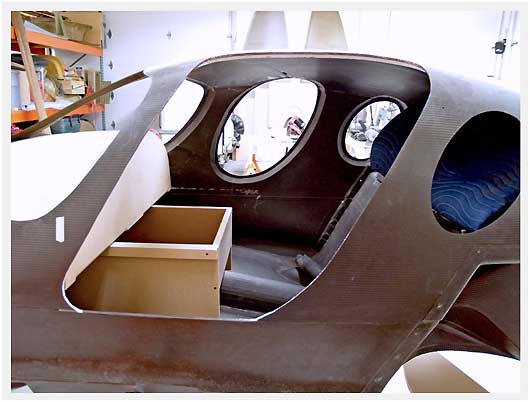 Cockpit and door opening for the pressurized LP1
Cockpit and door opening for the pressurized LP1
In this pic you can see the cockpit section and the early work being done to produce the tooling for making the instrument panel and center console parts. Much work on these items has recently been completed and more pictures can be viewed at the Woodward Aerospace Facebook page.
You can also see in the pic above the large opening for getting into the cockpit. The door will be a plug style that will seal from the inside, distributing the pressurization stresses around the entire edge of frame. The exact geometry of the how the door will move inside the cockpit is still being worked out. As the previous pic shows, the door opening extends fairly far toward the center of the fuselage allowing you to somewhat stand in the cockpit and then move down and into it.
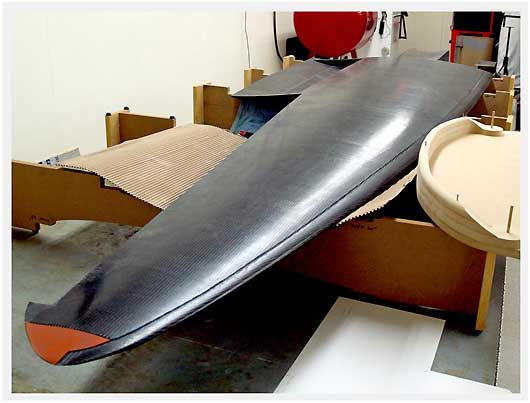

 Elliptical wing panels for the LP1 using the same carbon fiber nomex core sandwich
Elliptical wing panels for the LP1 using the same carbon fiber nomex core sandwich
The wings for the LP1 have a beautifully classic shape. They are also amazingly simple and robust looking. Again, the nomex core sandwich construction is used which allows for no ribs in the wing at all. The front and rear spars are molded right into the structure, and are actually an integral part of the skin. Lightweight fuel bladders will be installed which eliminates the concern over wet wing fuel leaks. The wings will also be fitted with fowler flaps.
Total wing area is 82.5 sq ft with a 23 lbs/sq ft wing loading. The span is 27 feet and the LP1 is 21 feet long. The airplane is intended to be extremely fast (385 mph) in high altitude cruise, in part due to the turbo-normalized Corvette engine, and in part due to the very light weight. That light weight should also help the airplane on the slow side of the speed spectrum as well. With a 42” wide pressurized cockpit, room for some bags, and what might wind up being an interior noise level low enough to fly without headphones, plus an airframe that should be able to be assembled in a very reasonable amount of time, the LP1 is promising a lot. In reality, can David Algie’s design live up to all of this? There’s really no way to know until it leaves the ground… but after having seen the airplane up close and talking to David, I think there’s a very good chance it will. But as with any project of this magnitude, and especially one that’s living pretty far outside the ‘normal’ box, the number of challenges and hurdles yet to clear might be great. Regardless, I’m very impressed and really excited to see this project reach the point when the fly-by-wire throttle will be advanced and that Corvette LS engine enthusiastically pulls the LP1 into the sky for the first time! If I had the money, there's no doubt I'd be putting my $5,000 deposit down on one today : )
Watch for lots more detailed coverage of the Algie Composite Aircraft LP1 in the future, including an upcoming podcast interview with designer/builder David Algie.
There are two websites to get a variety of additional info on the LP1, the Algie Composite Aircraft site, and the Woodward Aerospace site. There's also a very informative Yahoo group for the LP1.














































































Reader Comments (24)
That Is a Beautiful Plane, Very SEXY :) and its Begging to be a 4 seater :) keep up the Awesome work, Take care and have fun, Chellie
are you thinking of rengineering the front of the valley head(old school) intake to streamline the prop side of the top couling,i bet you could get 15mph more out of it,looks great you are going to kick every ones ass
David, i admit i dont see it in 3,4 or 5 D from theses pictures,but might i make a suggestion to just consider an extra plate welded onto your outboard landing gear bracket support plates that could be bolted to the floor,to help absort the side deflection on max impact because of the bracket bend......do you have to do a landing drop test ???in the barn
The plane was beautiful. It's my first time to see an an engine plane. It looks like a cars engine. Great dude. Keep it up.
always checking in,you are changing history,interesting flap mechanism,we use a similar gear/track in our application,our plastic tracks jam the gears when they get old
BUILD BABY BUILD
about static tests,i read Bill Lears book (300 or so pages)about 39 years ago,he described how he mounted the first Lear jets front landing gear to the front of his station wagon and drove it around. KellyJohnson also wrote a great book about designing and building the SR71 he asked for break fluid samples from suppliers that would take the heat,and one sent him a bag of dry crystals,you DAVID ALGIE are going to kick every ones ass
Looks good sounds good,AFTER EXTENSIVE PROP TESTING would it be a good idea? to dismantile a prop and examine the prop root around the metal anchor for micro cracking, to map out the stress fracturing , Ive always been conserned about this area
I love this plane but feel too much time has been spent on the engine . The whole thing is beautiful and great use has been made of the best of non-military composites. Hopeful, Mr. Rutan has checked in and given a few pointers. Keep up the excellent work.
David perfection does not live in time ask God.the time you contribute makes it the more wonderful
David your getting close now.....,ramp up security.....,remember Tesla and t henry Morey both had their labs distroyed by those in power who controled the statis quo,you are making history ,
always checking in
David this was a psycological attack to scare people away,probable orchestrated by the big companies,you are getting close,they are getting "nervious" of you,they should be !,you have the potential of taking alot of money out of their pockets,now about being unenlightend about pressurization ect....and its effects you will figure it out,it all started back with the first commercial passenger jet made in England it kept crashing for unknown reasonsI.I have calculated that 3.3Lbs of craft per HP will give you about 470 MPH ,I know your shooting for 385, I have total faith in you David, if he ....."Mr. Experimental" mouths off one more time well sent him back in time to Muroc to have his picture mounted on the wall. Best wishes ,always checking in..airport bum
David by looking at the number of posts for july i would think it has flown,i never register so please make a comment on the non registered part of your sight, good luck God speed:airport bum
David 99% or 101% of 100 is and is not the same ,this is an option for you gfx file speaking to build and break the production transfer/.not the"same plane" as in the original contract,partners are not a good idea in business,some are lazy and some steal.,read carefully and think
there is method in this written madness ,best wishes David ,airport bum
wel every team needs to decide what is important to them and make choices. Yes, we do end up with duplicate code sometimes, but it is not as bad as you would think. We depend on engineers to do the right thing, and we do a lot of code reviews.. Appliance Wire
Checking in David,looks like a long wait for justice in the courts,what did your partner(Woodward) do that pissed u off, I assume he pressured the completion,they always do that,my boss asked when I wound b finished on my project and I said "when it was done",Pope to Michel Angelo reguarding the cistine chapel,could you do a video on wing attachment?
Superb!!!
It just goes to show he knows what he's talking about am after my own heart.
Being a frustrated engineer myself and into everything that's out there suffering from an inexhaustible thirst for knowledge. He should look at Tenzaloy to replace all cast iron items as it has the same strength as cast iron being a third the weight!
It is mostly used in the machine tool industry but have never understood why it's not used for weight saving in many other applications.
Well done a slick piece of kit.
Nick Carroll
Taking a look accross the big Pond, this is in my opinion by far the most professional approach to a so called homebuild aircraft. The calculated performance is not out of a fantasy-box and might proof the exceptional concept of a weight saving Carbon Fiber design coupled with a modern automobile engine. I sure wish that David will get the bird into the air so as to enjoy his years of intensive work.
Kurt
David,
I have seriously considered using the Corvette LT4 ProCharger engine in a 1 + 6 Aircraft and believe this is financially viable, safe and cost efficient if engine tweaks and installation is done by experts. I see tremendous potential in you and this aircraft. This is a very promising model and a leap forward in creativity and innovation for General Aviation.
Kent
David algie,request wing attachment picks,you have the RIGHT stuff "make it happen captain"
David, have followed you for a long time. Very excited about what you are offering here. I am seriously concidering placing a deposit but want to know how the legal battle is going. wishing you the best of luck. Please keep us all posted
I was wondering if this aircraft project is still going and or if the company is still in business, the Woodward Aerospace Co? I can't find any information on either after about 2014, but maybe the name has changed, etc. Thanks for any comments, I would appreciate finding out if anyone out there may have obtained an STC for an auto engine conversion. Thanks, Gary gary@gwrauto.com
clevfruit e3d3fd1842 https://followgrown.com/sayjuhydli
clevfruit e3d3fd1842 https://followgrown.com/sayjuhydli